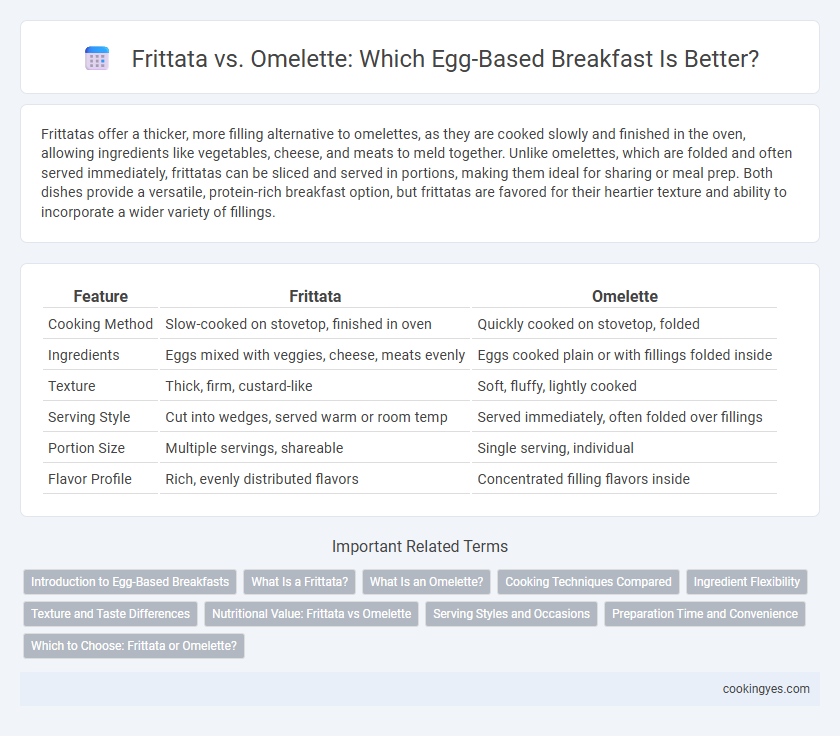Frittatas offer a thicker, more filling alternative to omelettes, as they are cooked slowly and finished in the oven, allowing ingredients like vegetables, cheese, and meats to meld together. Unlike omelettes, which are folded and often served immediately, frittatas can be sliced and served in portions, making them ideal for sharing or meal prep. Both dishes provide a versatile, protein-rich breakfast option, but frittatas are favored for their heartier texture and ability to incorporate a wider variety of fillings.
Table of Comparison
| Feature | Frittata | Omelette |
|---|---|---|
| Cooking Method | Slow-cooked on stovetop, finished in oven | Quickly cooked on stovetop, folded |
| Ingredients | Eggs mixed with veggies, cheese, meats evenly | Eggs cooked plain or with fillings folded inside |
| Texture | Thick, firm, custard-like | Soft, fluffy, lightly cooked |
| Serving Style | Cut into wedges, served warm or room temp | Served immediately, often folded over fillings |
| Portion Size | Multiple servings, shareable | Single serving, individual |
| Flavor Profile | Rich, evenly distributed flavors | Concentrated filling flavors inside |
Introduction to Egg-Based Breakfasts
Egg-based breakfasts like frittatas and omelettes offer versatile, protein-rich options for morning meals, each with distinct preparation techniques and textures. Frittatas are thick, open-faced dishes baked or cooked slowly, allowing for even distribution of ingredients like vegetables and cheese, while omelettes are quickly cooked and folded, often with fillings enclosed inside. Understanding these differences enhances breakfast variety and nutritional balance for egg enthusiasts.
What Is a Frittata?
A frittata is an Italian egg-based dish similar to an omelette but cooked slowly over low heat without folding, allowing ingredients like cheese, vegetables, and meats to be evenly mixed and set. Unlike an omelette, a frittata is finished in the oven or under a broiler to create a firm, fluffy texture throughout. Its preparation method results in a thicker, more substantial breakfast option that retains more fillings within the eggs.
What Is an Omelette?
An omelette is a classic egg dish made by beating eggs and cooking them quickly in a pan until set, often folded around fillings like cheese, vegetables, or meats. It features a soft, slightly fluffy texture and is typically smaller and thinner than a frittata. The rapid cooking process distinguishes an omelette from a frittata, which is cooked slowly and finished in the oven for a denser, more custard-like consistency.
Cooking Techniques Compared
Frittatas are cooked slowly over low heat or finished in the oven, allowing eggs to set evenly without folding, while omelettes are cooked quickly over medium-high heat and folded for a fluffy texture. Frittatas incorporate ingredients mixed into the eggs before cooking, resulting in a dense, open-faced dish. Omelettes typically have fillings added after the eggs are partially cooked, creating a layered and delicate consistency.
Ingredient Flexibility
Frittatas offer greater ingredient flexibility compared to omelettes by allowing a wider variety of vegetables, meats, and cheeses to be mixed directly into the eggs before cooking. Unlike omelettes, which typically require fillings to be folded inside, frittatas incorporate all ingredients evenly, creating a cohesive texture and rich flavor throughout. This versatility makes frittatas ideal for using leftover ingredients and customizing breakfast to dietary preferences or seasonal availability.
Texture and Taste Differences
Frittatas have a denser, more custard-like texture compared to the fluffier, lighter consistency of omelettes, as they are baked slowly and not folded. The taste of a frittata is richer and more savory due to the incorporation of various fillings like vegetables, cheeses, and meats mixed evenly throughout the eggs. Omelettes offer a more distinct contrast between the tender eggs and the fillings, with a quicker cook time that preserves a delicate, airy flavor.
Nutritional Value: Frittata vs Omelette
Frittatas typically contain more vegetables and cheese, resulting in higher fiber, protein, and calcium content compared to omelettes, which are often lighter with fewer fillings. The inclusion of diverse ingredients in a frittata enhances its overall nutritional profile, providing a balanced mix of macronutrients and micronutrients. Omelettes tend to have fewer calories and lower fat, making them a lighter option but less nutrient-dense than frittatas.
Serving Styles and Occasions
Frittatas are typically served in wedges, making them ideal for family-style meals or brunch gatherings where multiple servings are needed. Omelettes are often individually plated and customized, perfect for quick, single-person breakfasts or aesthetically focused occasions. The frittata's hearty, casserole-like nature suits casual, shareable dining, while omelettes cater to personalized, fast servings.
Preparation Time and Convenience
Frittatas require longer preparation time than omelettes because they involve baking or slow cooking to set the eggs evenly, making them ideal for meal prepping. Omelettes cook quickly in a skillet, providing a convenient option for fast breakfasts that need minimal monitoring. While omelettes offer speed and ease, frittatas excel in serving larger groups with versatile ingredients baked into a cohesive dish.
Which to Choose: Frittata or Omelette?
Frittatas offer a thicker, more filling option with ingredients mixed into the eggs and often finished in the oven, making them ideal for serving multiple people or meal prepping. Omelettes provide a quicker, foldable option with fillings added inside the egg fold, perfect for personalized, single servings with a softer texture. Choosing between a frittata and an omelette depends on desired portion size, cooking method, and texture preference for an egg-based breakfast.
Frittata vs Omelette for egg-based breakfast Infographic

 cookingyes.com
cookingyes.com